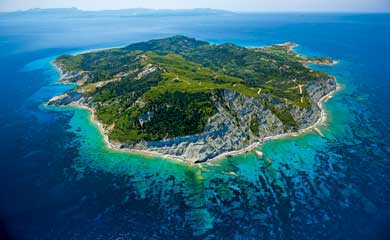The Diapontia, comprising a cluster of three small, verdant islands and a number of rocky, uninhabited islets, fade into the haze off the northwestern coast of Corfu. Until recent decades, Erikoussa, Mathraki and Othoni -- the westernmost part of Greece -- were rather inaccessible and among the last areas to join the national power grid. Tourist development is minimal and the islets are among the most scenic, tranquil and relaxed places to spend a holiday in Greece, ideal for reading and walking.

More recently, historical records show that the isles were first populated under Venetian rule in the 16th century. During British rule, which ended in 1864, they were used as places of exile for propagators of unification with Greece. Made up mostly of skilled seafarers, the population dropped sharply with the advent of the steamship; transatlantic emigration took the biggest toll. A reversal of the trend in the last 40 years or so, however, has breathed new life into the community.
While Othoni is mostly rocky, Erikoussa and Mathraki have hilly terrains, with several good beaches. Pastel pink- and ocher-painted houses are scattered amid the varying greenery provided by olive and cypress trees.
Erikoussa, 6 nautical miles from Corfu and the northernmost of the group, owes its name to the heather (“reiki” in Greek) which grows on the hillsides and bursts into flower in springtime. It is the most popular and most populous of the three, with a community of 700. The local port doubles as a splendid beach well protected from westerly winds. Erikoussa, with a total area of 4.5 square kilometers and its highest point at just 121 meters, is ideal for walking. One of the trails leads to Fyki Bay in the west (formerly the island’s port) and another to the vast sandy stretch of Bragini on the west coast. Porto, which has one hotel and some rooms for rent, is a great place to spend the night and enjoy some real peace and quiet after the last noisy groups of day-trippers depart.
Mathraki, the southernmost and smallest of the three, is 4.5 nautical miles northwest of Corfu. It has an area of 3.1 sq.km. and a population of just 300. There is no organized settlement here, just small clusters of houses that are separated into two districts, Ano Panta and Kato Panta. Mathraki is the least visited of the Diapontia, still waiting to be discovered by vacationers. Plaka, the port, has just four houses, a taverna-come-grocery store for the entire islet and the municipality bureau. Mathraki is crossed by footpaths offering opportunities for walks with spectacular views of the beaches, the sea, the nearby islet of Diaplo and three satellite rock islets -- according to legend, the boat and anchor of a pirate ship turned into stone when its crew attempted to pillage the Chapel of Aghios Nikolaos on Diaplo. The nearly 2-mile-long beach of Portelo on the east side of Mathraki (facing Corfu) is the highlight of the island. There is also Fyki Bay in the west and Apidies and Arvanitiko in the south.
Othoni (population 650) lies 12 nautical miles northwest of Corfu and covers an area of 10 sq.km. It has a jagged shoreline and an impressive landscape, with the highest peak at 393 m. The tiny port and pretty beach of Ammos lie on the southern coast and have most tourism facilities. Thick vegetation, rare rock formations and the small, scattered clusters of houses make for rewarding walks in the interior. Most of the shoreline is rocky and inaccessible. For swimming, head to Fyki in the north or Aspri Ammos in the southwest. Nearby is Calypso’s cave -- a 20-minute boat ride away from the local port. The charm of the place is such as to make it sound more convincing that Odysseus was in fact captivated by the place rather than held captive.
Author: Haris Argyropoulos | Source: ekathimerini [December 22, 2010]